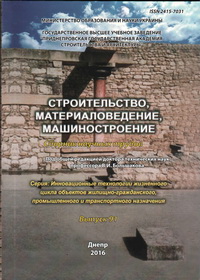Features of the method of calculation of limit states design in emergency situations
Keywords:
limit states, load-bearing capacity, emergency situations, limiting the load bearing structure, complete exhaustion of bearing capacity,Abstract
Annotation. The aim of the article is to illustrate some of the specific features of the method for calculating the limit states of structures in emergency situations. The relevance of research. The standards of design loads and forces encountered in emergency situations shall be considered as incidental, which are accounted in their respective emergency combinations. Themselves with the calculation methods are the same as in conventional design situations. For a number of unique buildings and structures the approach to the calculation results in an unjustified overestimation of metal bearing structures. In the article the examples of calculation of load-bearing steel structures in emergency situations, the full depletion of load-bearing capacity, which significantly reducesmetal consumption, and cost. Methods:implementation of the proposed article algorithms implemented in relation to steel beams. With the use of engineering methods are determined by quantitative evaluation of the limit loads for beams, corresponding to various regulatory requirements (regulatory limit states). Results:Quantitative evaluation of maximum loads, indicating that the calculation of load-bearing structures in emergency situations, the full exhaustion of their bearing capacity allows, in some cases significantly increase the maximum allowable load. Practical value:the general principles contained in Article algorithm can be extended to a number of other supporting structures, which should be designed taking into account the possible implementation of a particular emergency, adhering to such algorithms, it is possible to significantly reduce the consumption of materials and the cost of buildings and structures.References
Egorov EA Regulatory issues of reliability of metal construction /E.A.Egorov// News akademії.-Dnipropetrovs'k: Pdaba, 2008.-№10.-S.7-12. Egorov EA General principles of estimates the technical state of construction steel in service / E.A.Egorov // ~ Sat. nauch.tr. Construction, Materials, mashine engineering.-Dnepropetrovsk, 2005.-Vyp.35.-S.213-218.
Egorov EA Differentiated consideration of manufacturing and operating factors in the design and diagnosis of steel tanks /E.A.Egorov // Metal structures: a look into the past and future. VIII Ukrainian Scientific Conference. ST. Reports. ch.2. K .: Steel, 2004-S.224-233.
Egorov EA Studies tank designs: main results and prospects / E.A.Egorov // News akademії.-Dnipropetrovs'k: Pdaba, 2000.-№12.-S.30-33.
Gorokhov EV Durability of steel structures under reconstruction / E.V.Gorohov, S.N.Shapovalov. - M .: Stroyizdat, 1994. - S. 481.
Korolev VP task of rationing reliability coefficient for corrosion protection system "Load-Construction-Environment" /V.P.Korolev, R.G.Tolstyakov // Herald DonGASA. Vol. 98-4 (12). Construction koystruktsi, buildings and sooruzheniya.-Makiyivka, 1998.-S. 31-37.
DBN B.1.2-2: 2006 Loads and effects. Design Standards. Kiev. Ministry of Construction of Ukraine. 2006 - 87s.
DBN V.2.6-198: 2014 Stalevіkonstruktsії. Normie proektuvannya. Kiev. Mіnregіon Ukraїnі, 2014 - 202c.
Advice on protection of residential frame buildings during emergencies. Moscow, 2002.
Guidelines for the Protection of monolithic apartment buildings against progressive collapse. Moscow, 2005.
Recommendations for the protection of high-rise buildings from the progressive collapse. Moscow, 2006.
Downloads
Published
Issue
Section
License
Редакція Видання категорично засуджує прояви плагіату в статтях та вживає всіх можливих заходів для його недопущення. Плагіат розглядається як форма порушення авторських прав і наукової етики.
При виявлені у статті більш ніж 25% запозиченого тексту без відповідних посилань та використання лапок, стаття кваліфікується як така, що містить плагіат. У цьому випадку стаття більше не розглядається редакцією, а автор отримує перше попередження.
Автори, в статтях яких повторно виявлено плагіат, не зможуть публікуватися в усіх журналах Видавництва ДВНЗ «Придніпровська державна академія будівництва та архітектури».
Автори, які публікуються у цьому журналі, погоджуються з наступними умовами:
- Автори залишають за собою право на авторство своєї роботи та передають журналу право першої публікації цієї роботи на умовах ліцензії Creative Commons Attribution License, котра дозволяє іншим особам вільно розповсюджувати опубліковану роботу з обов'язковим посиланням на авторів оригінальної роботи та першу публікацію роботи у цьому журналі.
- Автори мають право укладати самостійні додаткові угоди щодо неексклюзивного розповсюдження роботи у тому вигляді, в якому вона була опублікована цим журналом (наприклад, розміщувати роботу в електронному сховищі установи або публікувати у складі монографії), за умови збереження посилання на першу публікацію роботи у цьому журналі.
- Політика журналу дозволяє і заохочує розміщення авторами в мережі Інтернет (наприклад, у сховищах установ або на особистих веб-сайтах) рукопису роботи, як до подання цього рукопису до редакції, так і під час його редакційного опрацювання, оскільки це сприяє виникненню продуктивної наукової дискусії та позитивно позначається на оперативності та динаміці цитування опублікованої роботи (див. The Effect of Open Access).

